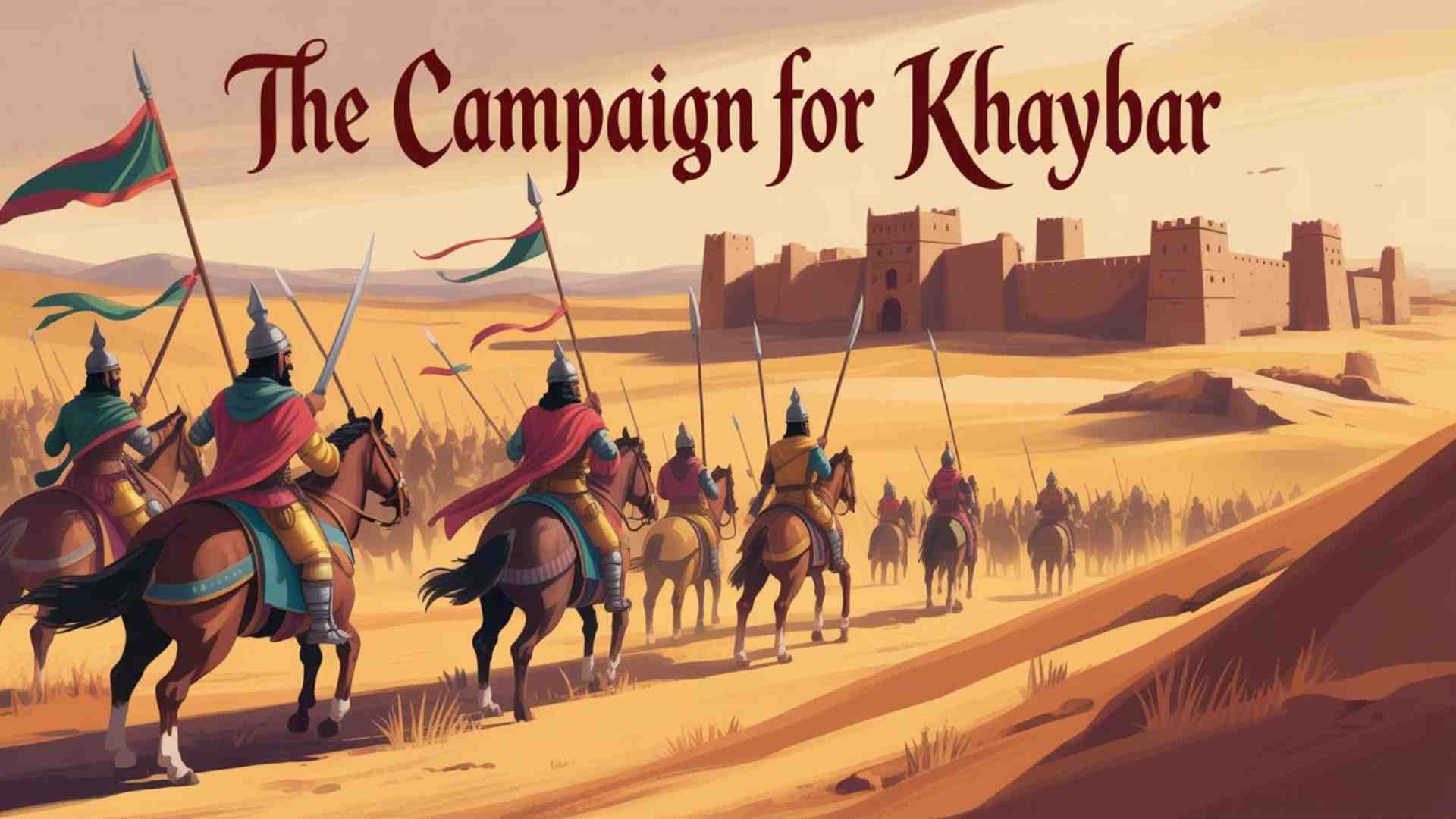The Battle of Khaybar (غزوة خیبر ) was one of the early Muslim community’s most significant expeditions against the Jewish tribes at Khaybar, in 628 CE. An oasis about 150 km (93 miles) northwest of Medina, Khaybar itself had a considerable Jewish population where agriculture and trade formed the hub of economic activity, although this oasis was not an ally of the people nearby due to the stronghold’s fortifications.
When the Muslim army landed outside Khaybar, they had no help from their allies, such as the Banu Ghatafan tribe of Jews, leaving them highly susceptible to the inexorable advance of the Muslim participants. The Muslim army laid siege to those fortifications to complete their takeover of Khaybar through a series of short battles for the fortifications. In the last battle, Ali ibn Abi Talib, RA, was victorious against Marhab ibn al-Harith, a Jewish commander with superstitions, in a duel, which is stated by many Muslims to be one of the most opulent accounts in the history of the Islamic movement.
After the victory, Prophet Muhammad ﷺ made fair and lasting terms of peace. The citizens of Khaybar were allowed to continue cultivating their land as long as they paid the jizya, a tax, and complied with the terms of the agreement. The wealth of Khaybar was distributed. The peace treaty gives the new Muslim state a strong economic and political grip while securing Madina’s northern border. The Battle of Khaybar was more than a military victory; it represented justice, strategy, and leadership. And it was a marker in the growth and consolidation of early Islam.
The Battle of Khaybar was what?
The Battle of Khaybar arose in the year 628 CE, the seventh year since the hijra. It was more accurately a campaign of sieges and conquest of different Khaybar Valley fortresses, even though it is commonly referred to as simply a battle. Conquering the fortresses took quite a bit of time and preparation, in part because they were adequately armed, stocked, and fortified.
The Muslims travelled from Medina under the command of Prophet Muhammad ﷺ. According to historians, the Muslim army consisted of about 200 horsemen and 1600 men. The Prophet ﷺ appointed trustworthy people and companions to lead smaller divisions, but he also maintained the unity and discipline of the army as a collective.
Reasons for the Khaybar Conflict
Rising Threats from Khaybar Tribes
Following the Battle of the Trench, many Jewish tribes were expelled from Medina for disloyalty and betrayal. Those who settled in Khaybar began to form alliances with the Quraysh and other hostile tribes from the Arab tribes that isolated the state and the Muslim community. Khaybar had become a fundamentally strategic threat to the Muslim and Islamic state.
News informed Medina that the leaders of Khaybar were forming a new coalition against the Muslims. The Messenger of Allah ﷺ used revelation and political astuteness to take action against the Khalid threat while it still did not pose a threat to the peace of Medina.
Strategic and Economic Considerations
Khaybar was very important agriculturally, known especially for its Bagh-e-Fidak (Garden of Fadak) and for date palms and fertile lands. Securing Khaybar also meant food security for the Muslim community; it also meant financial security for the Muslim community. Securing Khaybar also inhibited enemy plans to create an enemy base in Khaybar to attack Medina.
The Campaign For Khaybar

In the month of Muharram in the seventh year after the Hijrah, the Prophet Muhammad ﷺ departed for Khaybar and sequenced the plans of movement leading to Khaybar in secrecy for the Muslims until they were en route to the army so that the enemy would not expect their approach before they could prepare their course of action to prepare for battle.
As the Muslims arrived at the perimeter of the borders of Khaybar, the farmers were astonished and abandoned their oxen and cattle as they saw the Muslim army approach their town. The Prophet ﷺ lifted his hands and made du’a, “O Allah, Lord of the heavens and earth, and the Lord of the Mighty Throne, make our legs steady and give us victory.”
The Muslims rushed towards the Khaybar fortifications, and they did it with iman and their spirit, although it was evident to Allah and the Muslims that they were outnumbered immensely. The Khaybar fortification consisted of stone, and that fact alone would provide the Muslims with a significant challenge to overcome. However, neither of these physical threats could withstand the faith and belief of the Muslim army.
The Fortifications of Khaybar
Khaybar had a few fortifications that were known amongst the people, and they were as follows:
- Nata
- Al-Qamus
- Saʿb ibn Muʿadh
- Al-Katiba
- Al-Shaqq
These fortifications were considered fortified structures surrounded by thick walls and were defended by skilled archers. The Muslims took to laying siege by taking each of the fortifications one after another through courage and divine faith.
The First Fortress
The first fortification that was attacked was Nataʿ, and after great fighting, the fortification fell. Next came the fortification of Saʿb ibn Muʿadh, which could have additionally delayed them because it had a strong and high fortification. So, they waited behind the fortification, praying in the church, asking for victory.
The success of Ali ibn Abi Talib (RA)
At the last stronghold, Al-Qamus, the Muslims faced more acute obstinacy than ever before. And I will give the flag in the morning to a man who loves Allah and His Messenger and who is loved by Allah and His Message, the Prophet declared on this particular occasion. Through him, Allah will grant victory.
The following morning, Ali ibn Abi Talib (RA) received a call from the Prophet ﷺ. Ali RA had an eye infection. The Prophet ﷺ applied some of his blessed saliva to Ali’s eyes, and with Allah’s permission and whatever healing power that blessed saliva contained, Ali RA was cured. Ali RA took the flag, shouted “Allahu Akbar,” and charged into the battle against the enemy. In one of history’s epic duels, Ali RA faced Marhab, the champion warrior from Khaybar, one-on-one. With courage and strength, Ali RA struck him, breaking the morale of the people. After this, the fortress fell, and victory for Islam was secured.
The Settlement and Agreement of Khaybar
As the residents of Khaybar accepted the futility of their resistance, they petitioned for peace. The Prophet ﷺ acknowledged their plea under equitable terms. The Jews of Khaybar were allowed to settle in their lands and keep up farming there; however, they were expected to give half of the produce to the Muslims.
This would ultimately be beneficial for both parties; it would maintain productivity and promote stability. The Prophet ﷺ appointed supervisors to ensure fairness in terms of distribution. Shortly after, a similar agreement was reached regarding Bagh-e-Fidak, a neighboring landscape that came into Muslim possession peacefully.
Fadak and Its Historical Controversy
The Fadak garden (or Bagh-e-Fidak) was a gift from the land as Fay (land acquired and brought into possession without battle) presented to Prophet Muhammad ﷺ. Eventually, historical discussions emerged regarding ownership once he passed, resulting in the Fadak garden dispute. Depending on interpretations, history could provide a substantially different retelling of events; regardless, the accounts all note that Fadak made a substantial contribution to the early Muslim economy.
The Economic and Political Impact
Economic Strength
Khaybar gave the Muslim state a reliable economic basis. The income of Khaybar from its farms and trade supported some of the previously weak positions of the city of Medina. Many of the Libyan companions benefited from a share of the spoils, and other agreements, such as the one of Fadak, assured a financial future and growth.
Political Consolidation
The tribes in the area now regarded the Prophet ﷺ as their chief, which led to growing reputation issues for the Quraysh of Makkah, who in turn initiated negotiations in due course and did so without hostility as part of the Treaty of Hudaybiyyah.
Moral and Spiritual Lessons Learned from the Battle of Khaybar
Faith Before Numbers
The Muslim army was smaller in numbers and lacked the advantage of physical might, but they had great faith. The lesson of victory at Khaybar is that success comes in believing and standing together, not in material strength.
Leadership and Justice
The example of the Prophet Muhammad ﷺ is of wisdom, considering peace (even with his enemies) regardless of differences. Using his wisdom to be just to defeated tribes is a powerful model for leaders of all time.
The Courage Factor
Ali (ra) exhibited remarkable bravery, which remains one of the most important stories in Islamic history. His (ra) actions and try at Khaybar represent not only a strong military success but also the tenacity of a believer in Allah.
Key Insights
| Lesson | Description |
| Unity and Faith | True strength lies in unity under righteous leadership. |
| Justice in Victory | Instead of taking revenge, the Prophet ﷺ treated the beat fairly. |
| Economic Wisdom | The agreements of Khaybar and Fadak ensured stability and growth. |
| Moral Courage | The bravery of Ali (RA) reflects courage combined with piety. |

Conclusion
The Battle of Khaybar was a vital turning point in the evolution of justice, faith, and community, and it was more than a conquest, as the Prophet Muhammad PBUH had predicted. From Ali’s (RA) valor to the Prophet’s kindness during the failure, every moment embodied values that Muslims around the world can still recall. The victory at Khaybar marked the starting of the path to peace, harmony, and eventually the unification of Arabia under Islam.
FAQs (Frequently Asked Questions)
The Battle of Khabar took place in the seventh year of the hijra, which was 628 AD.
The commander general of the Muslims at Khaybar was Prophet Muhammad (PBUH).
Eventually, the Muslims came out on top and reached common ground with the Jewish farmers to remain on good terms.
It is a piece of rich land located in Khyber, and we believe that Bagh-e-Fidak, or the Garden of Fadakh, became part of Muslim control after the military campaign.
The Battle of Khaybar teaches us faith, courage, strategic power, and all key benefits in being successful both worldly and spiritually.
Related posts
RECENT POSTS
- Madina Ziyarat Places: A Deeply Human & Heartfelt Guide for Every Pilgrim November 29, 2025
- Saudi Bus Service 2025: Best Guide Every Traveler Needs November 27, 2025
- How to Perform Umrah in 2026: A Complete Step-by-Step Guide for First-Time Pilgrims November 25, 2025
ABOUT
Embark on your spiritual Umrah journey with tranquility-
We don’t just offer comfortable rides; we offer an experience
of reliability and convenience
RECENT POSTS
- Madina Ziyarat Places: A Deeply Human & Heartfelt Guide for Every Pilgrim November 29, 2025
- Saudi Bus Service 2025: Best Guide Every Traveler Needs November 27, 2025
- How to Perform Umrah in 2026: A Complete Step-by-Step Guide for First-Time Pilgrims November 25, 2025
ABOUT
Pellentesque sed risus feugiat lectus ornare pharetra nec id nisl. Sed dictum nunc a elit gravida consequat. In non accumsan nibh. Mauris at libero id magna viverra rutrum vel et felis. Suspendisse blandit tellus sed metus suscipit molestie.






Leave a Comment